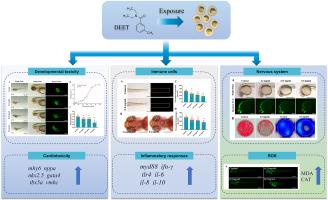Toxicity assessment of N, N-Diethyl-meta-toluamide (DEET) in zebrafish embryos
IF 4.3
3区 环境科学与生态学
Q2 BIOCHEMISTRY & MOLECULAR BIOLOGY
Comparative Biochemistry and Physiology C-toxicology & Pharmacology
Pub Date : 2025-07-17
DOI:10.1016/j.cbpc.2025.110293
引用次数: 0
Abstract
N, N-Diethyl-meta-toluamide (DEET) is a widely used insect repellent that can be detected in water and soil worldwide. Although adverse reactions have been reported following the use of DEET - containing products, there are few toxicity studies. In this study, zebrafish were exposed to 0, 0.2 mg/mL, 0.25 mg/mL, and 0.3 mg/mL of DEET. With increasing exposure concentrations, zebrafish mortality increased and body length development was reduced. At 72 hours post fertilization (hpf), zebrafish exhibited pericardial edema, decreased heart rate, and yolk sac edema. Significant abnormalities in the looping morphology of the heart were observed, with the atrium and ventricle positioned along the midline, resulting in cardiac linearization. The expression levels of genes related to cardiac development (myh6, nppa, nkx2.5, gata4, tbx5a, vmhc) increased. On the other hand, the quantity of neutrophils and macrophages exhibited a decrease, and the expression level of genes related to mediating inflammatory response (myd88, ifn-γ, tlr4) and inflammatory factor genes (il-6, il-8, il-10) increased. In addition, DEET exposure caused a reduction in newly generated neurons at 24 hpf. At 72 hpf, the activity of acetylcholinesterase (AChE) was inhibited, and motor behavior show that the total distance and average speed were significantly reduced. Further research found that oxidative stress was activated, and reactive oxygen species (ROS) content increased significantly. In summary, DEET cause multiple toxicities to the heart, immune system, and nervous system during early developmental stages of zebrafish embryos, and these toxicities may be induced by oxidative stress.

N, N-二乙基间甲苯酰胺(DEET)对斑马鱼胚胎的毒性评价。
避蚊胺(DEET)是一种广泛使用的驱蚊剂,在世界范围内的水和土壤中都能检测到避蚊胺。虽然使用含有避蚊胺的产品后有不良反应的报道,但很少有毒性研究。在本研究中,斑马鱼分别暴露于0、0.2 mg/mL、0.25 mg/mL和0.3 mg/mL的避蚊胺。随着暴露浓度的增加,斑马鱼死亡率增加,体长发育减少。在受精后72 小时(hpf),斑马鱼表现出心包水肿、心率降低和卵黄囊水肿。观察到心脏袢形态明显异常,心房和心室沿中线排列,导致心脏线性化。心肌发育相关基因(myh6、nppa、nkx2.5、gata4、tbx5a、vmhc)表达水平升高。另一方面,中性粒细胞和巨噬细胞数量减少,介导炎症反应相关基因(myd88、ifn-γ、tlr4)和炎症因子基因(il-6、il-8、il-10)表达水平升高。此外,避蚊胺暴露导致24 hpf时新生成的神经元减少。在72 hpf时,乙酰胆碱酯酶(AChE)活性受到抑制,运动行为表现为总距离和平均速度明显降低。进一步研究发现,氧化应激被激活,活性氧(ROS)含量显著增加。综上所述,避蚊胺在斑马鱼胚胎早期发育阶段对心脏、免疫系统和神经系统造成多重毒性,这些毒性可能是由氧化应激诱导的。
本文章由计算机程序翻译,如有差异,请以英文原文为准。
求助全文
约1分钟内获得全文
求助全文
来源期刊
CiteScore
7.50
自引率
5.10%
发文量
206
审稿时长
30 days
期刊介绍:
Part C: Toxicology and Pharmacology. This journal is concerned with chemical and drug action at different levels of organization, biotransformation of xenobiotics, mechanisms of toxicity, including reactive oxygen species and carcinogenesis, endocrine disruptors, natural products chemistry, and signal transduction with a molecular approach to these fields.

 求助内容:
求助内容: 应助结果提醒方式:
应助结果提醒方式:


